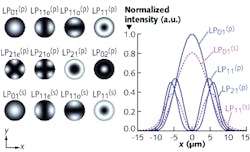OPTICAL FIBER AMPLIFIERS: Few-mode fiber amplifiers assist spatial-division multiplexing
To increase the transmission capacity of a single optical fiber, an alternative to dense wavelength-division multiplexing (DWDM) called spatial-division multiplexing (SDM) has been proposed using either multicore optical fibers or few-mode fibers (FMFs).
The FMFs are a type of fiber with a core area large enough to transmit parallel data streams in a few independent spatial modes. Ideally, the capacity of an FMF is proportional to the number of modes. However, to extend transmission distance, few-mode fiber amplifiers are required that—unlike those used in free-space optical communication and high-power laser applications—have controllable mode-dependent gain to ensure all SDM channels are optimized.
Now, researchers at CREOL—The College of Optics & Photonics at the University of Central Florida (Orlando, FL)—and NEC Laboratories America (Princeton, NJ) have developed a method for controlling modal gain in a few-mode erbium-doped fiber amplifier (FM-EDFA) to expand the viability of mode-division-multiplexed optical communications networks.1
Controlling MDG
Mode-dependent gain (MDG) is a function of the overlap integral among the concentration profile of the active dopant ions and the transverse intensity profile of the pump and the signal. Modal gain can be tuned by fiber design to control the dopant profile and signal intensity profile. After the doped fiber has been fabricated, dynamic control of the MDG can be realized by controlling the mode content of the pump.
The FM-EDFA consists of 15 m of few-mode erbium-doped fiber with a 16-µm-diameter doped core that supports two mode groups—LP01(s) and LP11(s)—at the signal wavelength around 1550 nm, and four mode groups—LP01(p), LP11(p), LP21(p), and LP02(p)—at the pump wavelength around 980 nm.
Within the mode groups such as LP11(s), LP11(p), and LP21(p), two types of degenerate modes sharing the same propagation constant can be recognized as even and odd modes as defined by their parities in angular dependence (see figure).
To demonstrate MDG control using the amplifier setup, the pump source is split into N paths using spatial filters (mode converters) and optical variable attenuators (OVAs) to generate the N pump modes. The N signal modes are spatially combined using a beam combiner and input to the signal path via a dichroic mirror. By tuning each OVA, the power of individual pump mode content can be adjusted, thus enabling control of pump-signal overlap as well as MDG.
Using the FM-EDFA, the researchers successfully transmitted a 26.4 Tbit/s mode-division multiplexed DWDM signal over 50 km of few-mode fiber with an FM-EDFA before the receiver.2 The received signal was detected using three synchronized coherent receivers and mode coupling, modal group delay, and chromatic dispersion were compensated with a digital multiple-input multiple-output (MIMO) equalizer.
The experiment demonstrated MDG control and resulted in a bit-error rate (BER) of less than 3.8 × 10-3 for all channels, adequate for error-free transmission after forward-error correction. “The FM-EDFA may potentially be a key element for future long-haul SDM transmission systems,” says Neng Bai, a PhD candidate at CREOL. “We look forward to working with industry to realize low-complexity, high-efficiency FM-EDFAs.”
REFERENCES
1. N. Bai et al., OFC/NFOEC 2012, Special Symposium on Enabling Technologies for Fiber Capacities Beyond 100 Terabits/second, paper OW1D.3 (Mar. 7, 2012).
2. N. Bai et al., Opt. Exp., 20, 3, 2668 (2012).
About the Author

Gail Overton
Senior Editor (2004-2020)
Gail has more than 30 years of engineering, marketing, product management, and editorial experience in the photonics and optical communications industry. Before joining the staff at Laser Focus World in 2004, she held many product management and product marketing roles in the fiber-optics industry, most notably at Hughes (El Segundo, CA), GTE Labs (Waltham, MA), Corning (Corning, NY), Photon Kinetics (Beaverton, OR), and Newport Corporation (Irvine, CA). During her marketing career, Gail published articles in WDM Solutions and Sensors magazine and traveled internationally to conduct product and sales training. Gail received her BS degree in physics, with an emphasis in optics, from San Diego State University in San Diego, CA in May 1986.
